Part 1 of this article appeared in the November issue and introduced the need for new low-cost, lightweight, flexible thin-film solar cells based on abundant and easy-to-process organic materials. It included a tutorial on how organic thin-film solar cells work and how their performance is measured, and it concluded with a description of the research on polymer organic solar cells being conducted at Stanford by Michael McGehee’s group.
Gary C. Bjorklund and Thomas M. Baer, Stanford Photonics Research Center
Although extremely simple in concept, successful photovoltaic devices for solar energy production will require the optimization of many different parameters involving material electron donor properties, electrode configurations, substrate mechanics and fabrication methods. A multidisciplinary approach will be required to achieve the necessary performance and cost improvements. Progress depends on the close collaboration of talented researchers with a broad range of skills that span a multitude of disciplines, ranging from synthetic chemistry to chemical engineering to materials science to optical characterization of materials to photonic device design. At Stanford Photonics Research Center, such collaborations are taking place.
Small-molecule organic cells
For example, Professor Peter Peumans of the electrical engineering department at Stanford University has a background in optical components and materials stemming from his research at Princeton University while obtaining a doctorate in electrical engineering. At Stanford, he has been leading a research effort to make efficient solar cells based on small-molecular-weight materials.1,2,3
There is a host of known candidates for light-absorbing electron-donor molecules, namely pigments that have been developed to provide colors for industrial applications. These pigments are stable, abundant, low-cost, nontoxic and available in quantity. Similarly, a variety of small-molecular-weight electron-acceptor materials also are readily available. A major advantage of these small-molecule materials compared with large-molecule polymers is that vacuum sublimation can be used to form well-controlled amorphous or polycrystalline thin films on flexible polymeric substrates. As a result, they can be used to fabricate complex multilayer devices, and there is no need to make the molecules soluble. Moreover, they also are very easy to purify.
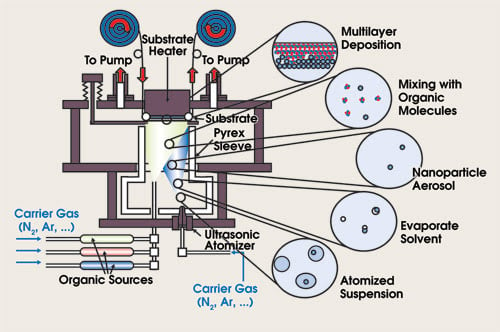
Figure 1. In the roll-to-roll vacuum coating method for production of small-molecule solar cells, the roll on the top left continuously plays out a sheet of flexible substrate material. The sheet passes through a seal into the vacuum chamber, where it is heated and bombarded with a controlled mixture of organic gas sources and metal nanoparticles to form the desired multilayer structure. The coated sheet then passes through another seal and is collected by the roll on the top right. The circled diagrams on the right show the various stages in the preparation of the organic gas/metal nanoparticle mixture.
Peumans is developing a technique for making low-cost roll-to-roll vacuum coating that could be used to produce these solar cells (Figure 1). Similar techniques have been highly developed in the food-packaging industry — for example, aluminum moisture-barrier layers on plastic containers for potato chips. Coating equipment has been developed that can coat 4-m-wide rolls at a rate of 1000 m/min, resulting in a throughput of 240,000 square meters per hour. It remains to be proved that organic solar cells can be produced at a similar throughput, but if the researchers are successful, and if 10 percent efficiency can be achieved for solar cells produced by this method, 100 such coating machines could satisfy current worldwide demand.
An alternative method of fabrication is organic vapor phase deposition.4 Here precursor organic compounds are carried by an inert carrier gas into a region where they are disassociated by heat or plasma bombardment to form the molecules to be deposited. This method allows good thickness and dopant control, eliminates parasitic coating on the walls of the chamber and allows the fabrication of complex multilayer devices.
One central question that Peumans addresses in his more basic research is how electrons, holes and excitons interact in the nanoscale device geometries required for efficient solar cell operation. A link between the degree of order of molecular packing and the diffusion length of excitons also was demonstrated recently by Peumans’ team. Figure 2 shows some modeling results for solar cells with different nanostructures.
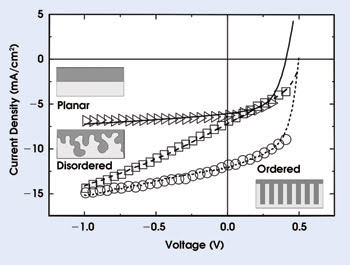
Figure 2. These theoretical and experimental I-V curves compare the performance of solar cells with planar (as in Figure 1 of Part 1), disordered (as in Figure 5 of Part 1) and ordered (as in Figure 2 of Part 1) buried heterojunction nanostructures. The ordered nanostructure has the highest performance. The disordered nanostructure slightly outperforms the planar nanostructure but underperforms the ordered nanostructure because not all of the carriers have straight paths to the electrodes.
Recently, Peumans and his group used metal nanoparticles to achieve plasmonic enhancement of small-molecule organic solar cells.5,6 Figure 3 shows the structure of one of the experimental cells. Enhancements resulting from plasmonic effects were observed when either gold or silver nanoparticles were introduced near the junction region between the donor and acceptor materials. These plasmonic effects produce an increase in the optical absorption that is confined to an ~10-nm region near the metal nanoparticles.
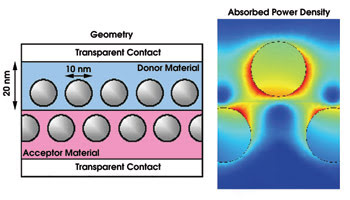
Figure 3. Metal nanoparticles enhance solar cell performance by increasing the optical absorption — and thus the creation of excitons — in the vicinity of the donor-acceptor interface.
By placing the nanoparticles in the junction region, this increase in optical absorption produces a higher density of excitons in the critical region within a diffusion length of the junction, resulting in more efficient collection. In experiments, a 50 percent increase in solar cell efficiency was observed by embedding insulator-coated gold nanorods and nano-spheres near the donor-acceptor interface.
Another application of metal nanostructures recently was developed by Peumans’ group in collaboration with professor Yi Cui’s group in the materials science and engineering department. This team demonstrated that solution-processed random meshes of metal nanowires can form transparent electrodes with a performance that is equivalent to that of indium tin oxide films (Figure 4). This is an important step toward lowering the cost of large-area solar cells, because sputtered metal-oxide films such as indium tin oxide are probably too expensive for practical solar cells. Hybrid transparent-mesh electrodes combining metal nanowires and the carbon nanotubes described in Part 1 of this article eventually may offer superior performance at significantly reduced cost.
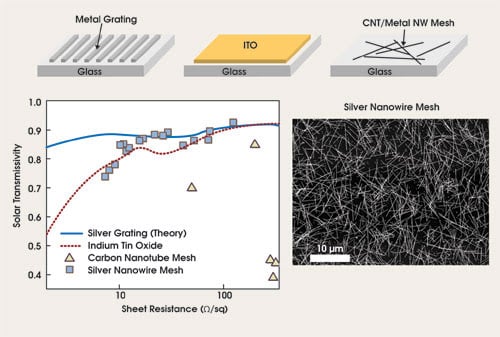
Figure 4. Shown is a comparison of metal grating, ITO (indium tin oxide), carbon nanotube (CNT) mesh and metal nanowire (NW) mesh transparent electrode materials.
Organic solar cell materials
Professor Zhenan Bao brings a different perspective and skill set to solar cell research with her background in synthetic organic chemistry. Bao is a faculty member in the department of chemical engineering and has a doctorate in chemistry from the University of Chicago. After graduation, she spent eight years in industry working at Bell Laboratories developing flexible electronic devices using polymer and organic materials. At Stanford, besides studying flexible electronics, she recently launched a research program aimed at novel organic materials for solar cells that leverages her group’s expertise and experience with developing novel organic materials for electronics.7-10
There is a great research opportunity for the synthesis and characterization of entirely new organic materials for solar cells. These new materials could provide adjustable bandgaps and other optoelectronic properties while maintaining high absorption coefficients, good mechanical properties and excellent processing conditions from solution. Additional target properties for organic donor materials are high mobility, low bandgap to match the solar emission spectrum (in the range of 1.2 to 1.7 eV), long exciton diffusion length and absorption of multiple low-energy photons to produce a single higher-energy exciton.
Motivated by the high carrier mobility, by the absorption at relatively long wavelengths and by the long exciton diffusion lengths that have been observed for pentacene organic materials, Bao and her group have synthesized a number of pentacene and thiophene derivatives. The top portion of Figure 5 shows four of these new donor molecules. The basic pentacene structure is a linear hydrocarbon with five contiguous benzene rings fused together.
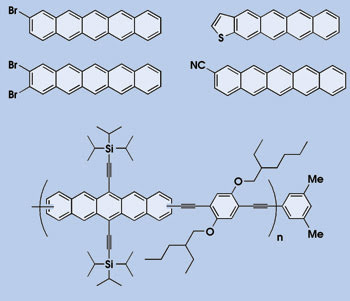
Figure 5. The top four molecules shown here are pentacene and thiophene derivatives with altered properties such as bandgap energy, absorption coefficient, exciton diffusion lengths, carrier mobility and solubility. The molecule at the bottom of the figure is a pentacene-containing polymer that exhibits the solar cell advantages of pentacene, but because it’s a polymer, it is solution-processible and enables solar cell fabrication by solution coating or printing methods.
Bao and her group have measured the performance of these new electron donor materials in solar cell structures similar to the one shown in Figure 1 in Part 1 of this article. The new electron donor materials’ characteristics were compared with those of pentacene as a baseline, and promising results were obtained with tetraceno[2,3-b] thiophene (ThioT). The material showed efficiency comparable to that of pentacene, even though its bandgap is larger by 0.2 eV. An interesting trend is that the solar cell performance improves with annealing at elevated temperatures. Future work will probe structure-quantum efficiency relationships with a larger family of pentacene derivatives.
Additionally, solution-processible pentacene-containing polymers have been synthesized and should make possible solar cell fabrication by solution coating or printing methods. The bottom portion of Figure 5 shows one of these new polymers.
Together with industrial collaborators, Bao’s team is working with Peumans’ group to explore new materials with optimal bandgaps, energy levels, carrier mobilities and exciton diffusion lengths for use in multijunction organic solar cells. Such multijunction cells improve the efficiency of organic solar cells drastically, and in principle, efficiencies similar to or better than crystalline silicon are possible. Because many interesting materials neither dissolve nor sublime, new thin-film processing methods are being developed.
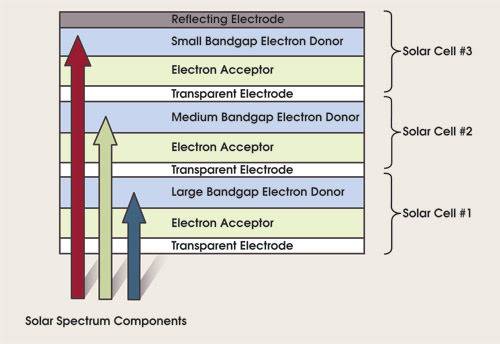
Figure 6. Various portions of the solar spectrum are absorbed at a range of places in a multijunction organic solar cell.
Producing new organic materials with bandgaps at various energies that correspond to solar spectrum components is critical for making organic multijunction solar cells that efficiently convert sunlight into electrical power. As shown schematically in Figure 6, such a multijunction cell can be fabricated as a stack of organic thin-film solar cells, each made with a light-absorbing electron donor material with a different bandgap. The incident sunlight impinges first on cell No. 1, which contains the highest bandgap electron-donor material. The most energetic solar photons (blue arrow) are absorbed and converted to current in cell No. 1, while the medium-energy photons (yellow arrow) and low-energy photons (red arrow) pass through unattenuated. The remaining light impinges on cell No. 2 — which has medium bandgap material — and the medium-energy photons are absorbed and converted to current. Finally, the low-energy photons are absorbed and converted to current in cell No. 3. Besides converting nearly all of the components of the solar spectrum into current, the higher-energy photons produce a higher voltage output because they excite a higher-energy exciton. The same current density flows through each of the cells. The output voltage of the multijunction device is the sum of the voltages produced by each of the cells.
Future progress
Since 1995, the worldwide effort to improve the efficiency of thin-film organic solar cells has resulted in considerable progress. Figure 7 shows power conversion efficiencies that have been obtained for both polymer and small-molecule-type solar cells. Extrapolation of the trend line shows that organic solar cells are likely to become competitive with amorphous silicon solar cells in power conversion efficiency.
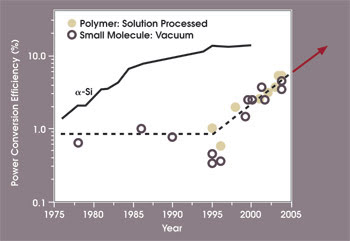
Figure 7. Progress in power conversion efficiencies of thin-film organic solar cells has been impressive during the past decade. α-Si information from C. Wronski. Data taken at ~AM 1.5 100 mW/cm2.
For polymer-based solar cells, continued progress depends on the synthesis of organic semiconducting polymers with lower bandgaps, on the discovery of energy transfer mechanisms that can be used to direct excitons to the interface from more than 20 nm away, on the development of methods for patterning 20-nm-wide holes with straight walls that are 200 nm deep in a suitable electron-acceptor semiconductor and on better control of the interface between donor and acceptor. In addition, to approach 20 percent efficiency most likely will require multijunction cells composed of materials with varying bandgaps.
For small-molecule-based solar cells, continued progress depends on the synthesis of new electron donor molecules with intense absorption bands at both shorter wavelengths and longer wavelengths, on better understanding of contacts and doping, on nanostructured interfaces between donor and acceptor and on the introduction of metal nanostructures to enhance optical absorption near the interface. As in the case of the polymer-based cells, multijunction cells composed of materials with varying bandgaps will be required to approach 20 percent efficiency.
Acknowledgment
Peumans’ work is sponsored by the National Science Foundation, the Global Climate and Energy Project at Stanford, BASF Corp., the Air Force Office of Scientific Research, Applied Materials Inc. and the US Department of Energy. Bao’s work is sponsored by the Global Climate and Energy Project and by the Air Force Office of Scientific Research.
Meet the authors
Gary C. Bjorklund is the consulting director for Solar Cells, Telecom and Information Technology at Stanford Photonics Research Center; e-mail: [email protected].
Thomas M. Baer is the executive director of Stanford Photonics Research Center; e-mail: [email protected].
References
1. P. Peumans (Feb. 24, 2007). Small molecular weight organic solar cells. SPRC workshop: Solar Cell Technology Options: Paths to lower $ per watt, Stanford University, Stanford, Calif.
2. P. Peumans et al (Sept. 11, 2003). Efficient bulk heterojunction photovoltaic cells using small-molecular-weight organic thin films. NATURE, pp. 158-162.
3. P. Peumans and S.R. Forrest (Nov. 1, 2004). Separation of geminate charge-pairs at donor-acceptor interfaces in disordered solids. CHEM PHYS LETT, Vol. 398, pp. 27-31.
4. M. Shtein et al (April 1, 2003). Micropatterning of small molecular weight organic semiconductor thin films using organic vapor phase deposition. J APPL PHYS, Vol. 93, pp. 4005-4016.
5. P. Peumans (2006). Metal nanostructure enhanced organic solar cells. Electronic Materials Conference, University Park, Pa., June 28-30.
6. J.Y. Lee et al (Feb. 24, 2007). Plasmonic enhancement of organic photovoltaic cells. SPRC Workshop: Solar cell technology options: Paths to lower $ per watt, Stanford University, Stanford, Calif.
7. M.L. Tang et al (Feb. 24, 2007). New organic materials for solar cells. SPRC Workshop: Solar cell technology options: Paths to lower $ per watt, Stanford University, Stanford, Calif., Feb 24.
8. M.L. Tang et al (Dec. 20, 2006). High-performance organic semiconductors: Asymmetric linear acenes containing sulphur. J AM CHEM SOC, Vol. 128, pp. 16002-16003.
9. T. Okamoto and Z. Bao (Aug. 29, 2007). Synthesis of solution-soluble pentacene-containing conjugated copolymers. J AM CHEM SOC, Vol. 129, pp. 10308-10309.
10. T. Okamoto et al (October 2007). Synthesis, characterization, and field-effect transistor performance of pentacene derivatives. ADV MATER, Vol. 19, pp. 3381-3384.